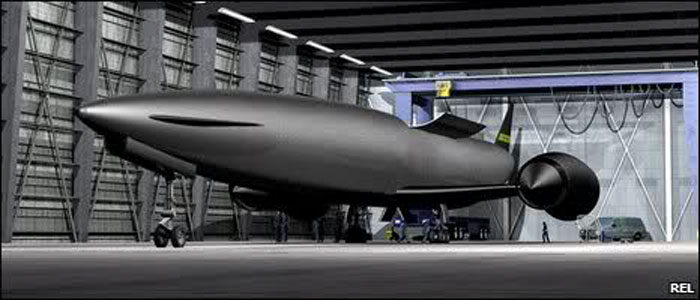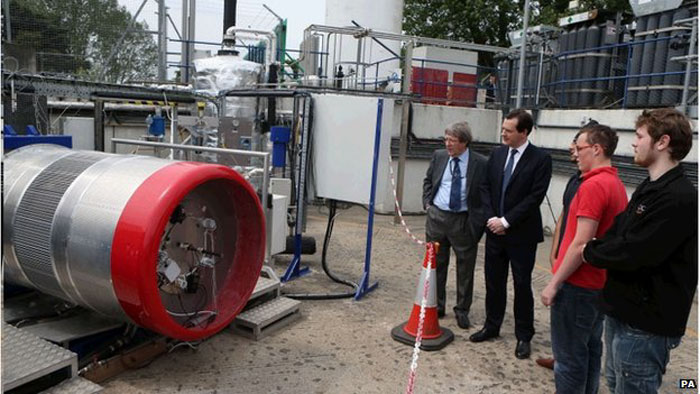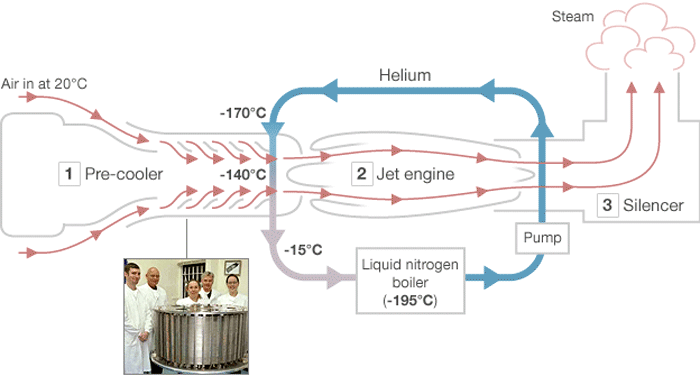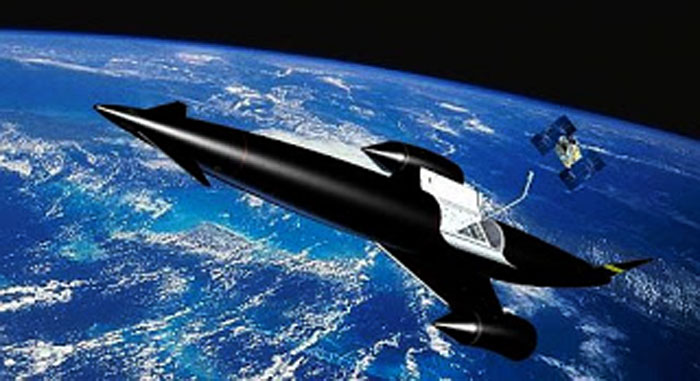.

Skylone-Antrieb macht Fortschritte
.

George Osborne sees the proof-of-principle Sabre test rig at the Culham science park
.
The UK government is putting £60m into the revolutionary Sabre engine, but its inventors will need about four times this sum to produce the final design.
Discussions with private investors are now under way to secure the additional funding, says project leader Alan Bond.
Sabre is a jet-cum-rocket that could, say its supporters, propel a fully re-usable space plane into orbit.
Chancellor George Osborne has witnessed a display of its enabling technology, and is excited by the innovation.
He intends to release £35m in 2014-15 and a further £25m in 2015-16 to help Mr Bond conclude the power unit's development phase.
This would see the construction of a demonstration engine and a blueprint for manufacture.
Mr Bond, the chief engineer at Reaction Engines Ltd (REL), said the next nine months should see the extra financing come together.
"The value of the next phase of development is of the order of £200m-plus, and the government's investment represents about 25% of the total.
"I cannot go into detail at this time because it's commercially confidential, but I have every belief that the other investment will come along to support the programme," he told BBC News.
The Sabre (Synergistic Air-Breathing Rocket Engine) concept is for a power unit that can operate like a jet turbine at low speed and then transition to a rocket mode at high speed.
It would burn hydrogen and oxygen to provide thrust, but at low altitudes this oxygen would be taken straight from the atmosphere.
The approach should save weight and allow Sabre to impel a space vehicle straight to orbit without the need for the multiple propellant stages seen in today's throw-away rockets.
Crucial to the engine's performance, however, is a compact pre-cooler heat-exchanger that can take an incoming airstream from over 1,000C to -150C in less than 1/100th of a second.
This pre-cooler module contains arrays of extremely fine piping that dump energy very efficiently but also avoid the frost build-up that might otherwise compromise their operation.
A series of "proof of principle" experiments has passed an independent audit from European Space Agency (Esa) experts, and Mr Osborne himself has inspected the test rig on the Culham science park in Oxfordshire.
.

A concept drawing of the Sabre engine with a series of pre-cooler modules
.
The UK government's science minister, David Willetts, said he and Mr Osborne had been very impressed.
"It is because of the clear evidence that Reaction Engines has passed crucial technical tests - that the principles have been established; that the technology has been proven - that the British government has taken this very significant decision to invest £60m in REL.
"The technologies that particularly interest us are disruptive technologies that can have a wide effect.
"The experts have convinced me that this heat exchanger is not simply for use in the space industry - it has many other applications as well. I've been told, for example, that for desalination plants it could be of great significance."
It is conceivable this technology might also be used within the atmosphere to shorten journey times from one side of the globe to the other. Brussels to Sydney could be done in four and a half hours by a Sabre-equipped airliner.

Sabre's trick: Hot air passes over the piping, plunging to -150C in just 1/100th of a second
.
This final phase of engine development should get under way in earnest at the start of next year, and, once again, it will be supported by Esa.
The agency's propulsion experts will offer their insights on many technical aspects of the programme, but they plan also to provide due diligence to ensure REL delivers against milestones.
The desire is to have a full set of engineering drawings completed by the end of 2017 that would enable a real flight model of Sabre to be manufactured.
Before then, REL hopes also to have produced a ground demonstrator.
"I always liken the demonstrator to a dissected rabbit, with all its organs spread out," explained Mr Bond.
"It would not resemble a flight engine, but it will have all the correct features of a real engine, and it will show that it's controllable, that it's self-sustaining and indeed that it can simulate operation from take-off conditions."
The head of Esa's mechanical engineering department, Constantinos Stavrinidis, said the agency took the view that Sabre was a realisable technology, but that it might be some years yet before the engine got into the skies.
"It took a while before steamships took over from clippers; it took a while before jet engines took over from propellers. But I'm convinced this is the last frontier: utilising oxygen from the atmosphere. This technology - the heat exchanger - has demonstrated that it can work," he told BBC News.
Sabre engine: How the recent "proof of principle" experiments were conducted

1. Pre-cooler
During flight air enters the pre-cooler. In 1/100th of a second a network of fine piping inside the pre-cooler drops the air's temperature by well over 100C. Very cold helium in the piping makes this possible.
2. Jet engine
Oxygen chilled in the pre-cooler by the helium is compressed and burnt with fuel to provide thrust. In the test run, a jet engine is used to draw air into the pre-cooler, so the technology can be demonstrated.
3. The silencer
The helium must be kept chilled. So, it is pumped through a nitrogen boiler. For the test, water is used to dampen the noise from the exhaust gases. Clouds of steam are produced as the water is vapourised.
Quelle: BBC
.

6392 Views
